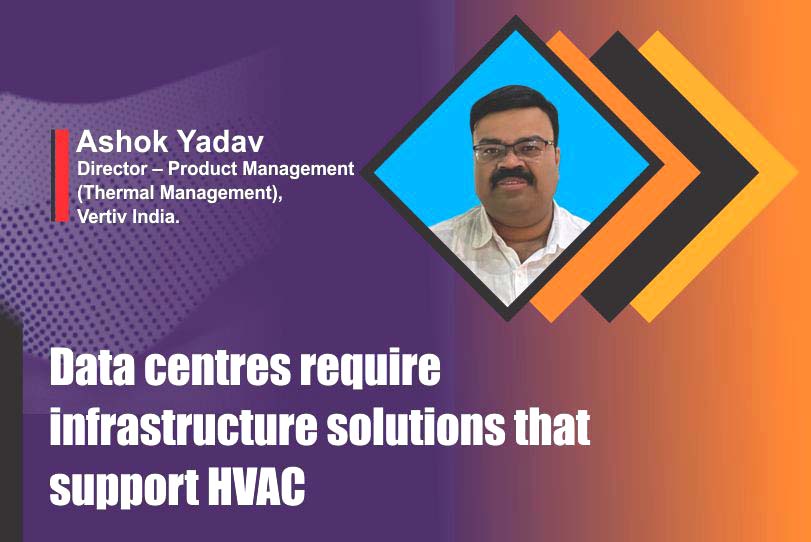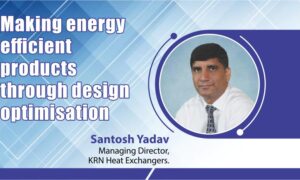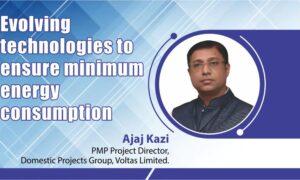By making use of IoT, 5G networks, and barcode technologies, businesses can take preventive measures to manage their equipment from any location.
As technology and innovation take centre stage across organisations in India, IT infrastructure plays a crucial role in ensuring a smooth digital transformation. Studies suggest that the Indian heating, ventilation, and air conditioning (HVAC) market was $8,526.7 million in 2019 and is expected to grow to $31,598.6 million by 2030. That is a CAGR of 16 percent during the forecast period. Ashok Yadav, Director – Product Management (Thermal Management), Vertiv India remarks that ever since the pandemic hit, the industry has been facing challenges both from a demand and supply standpoint. With the economy slowly coming back to pre-pandemic conditions, supply chains that were disrupted are now getting back to normal operations. And things are looking brighter for the HVAC industry.
In 2022, some of the things HVAC players could look forward to are an increase in software automation and adoption of Internet of Things (IoT) to gather data from their systems and enable them to innovate their product portfolio accordingly. With several sectors looking to adopt more sustainable business strategies, it will be crucial for HVAC systems to be smart and more energy efficient to ensure they align with their customers’ evolving requirements.
Data Centre cooling will revolve around energy optimisation and adoption of disruptive technologies. Customers in today’s circumstances are increasingly willing to adopt new, non-explored technologies without any hesitation. We anticipate that there will be an increase in hybrid technology adoption by customers along with a heavy reliance on data for optimisation.
Product range of Vertiv, the digital infrastructure provider
Vertiv is a digital infrastructure provider that brings together hardware, software, analytics, and ongoing services to ensure its customers’ vital applications run continuously, perform optimally, and grow with their business needs. Vertiv solves the most important challenges facing today’s data centres, communication networks and commercial and industrial facilities with a portfolio of power, cooling, and IT infrastructure solutions and services that extends from the cloud to the edge of the network. Vertiv’s portfolio includes- critical power solutions like UPS, DC power systems, industrial ACs, etc., thermal management solutions like enclosure cooling, heat rejection, room cooling, etc., racks and enclosures, and other maintenance and service solutions.
Data centres require infrastructure solutions that support IT growth while offering greater efficiency and cost reduction. Vertiv’s portfolio of solutions provides support to critical facilities like efficiency, interoperability, and control to implement an intelligent and integrated infrastructure strategy.
Measures and solutions that improve energy efficiency in air conditioning and refrigeration
Every industry, be it manufacturing, banking and finance, education, transport and logistics, or retail, is adopting smart technologies to make the organisation more efficient.
The HVAC industry is no different. Businesses across the sector will increasingly adopt smart technologies and sensor technologies to monitor and analyse the condition of their equipment. Technologies like smart thermostats and direct digital controls (DDC) systems will slowly become mainstream to help monitor and even diagnose any potential and real-time problems remotely. This will ensure the systems are running smoothly and are consuming optimal amounts of energy.
By making use of IoT, 5G networks, and barcode technologies, businesses can take preventive measures to manage their equipment from any location. Automating the heating and cooling systems, the speed at which the system operates, and run time of the equipment will help improve the overall maintenance of the equipment. By reducing repair costs, downtime and unexpected malfunctions, businesses can increase the efficiency of the HVAC systems.
There is a rise anticipated in the adoption of both software and hardware solutions based on Artificial Intelligence and Machine Learning algorithms, which will capture the behaviour of units and requirements of the target applications. These solutions enabled with Internet of Things (IOT) technologies will work towards energy optimisation of the entire facility based on the system’s performance.
Automation trends visible in the HVAC industry Automation of HVAC equipment can have a positive impact on the overall business. In terms of monitoring and maintenance, by making use of sensors, motion-activated heating and cooling, businesses can ensure that their systems are running efficiently and avoiding any unnecessary use of energy.
Automation has numerous benefits, not just in terms of monitoring their equipment, but even from a sales and customer service standpoint. Through automation, HVAC system providers can speed up the invoicing process, payments, and communicate with customers. Technical and support staff can also be assigned their schedules remotely and can be altered real-time, if necessary, based on new service requests and location of the customer to better manage daily tasks.
Cookie Consent
We use cookies to personalize your experience. By continuing to visit this website you agree to our Terms & Conditions, Privacy Policy and Cookie Policy.















